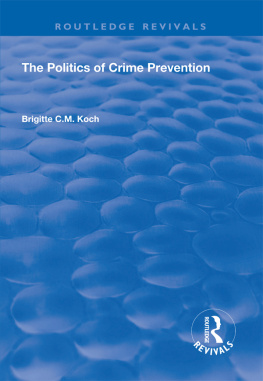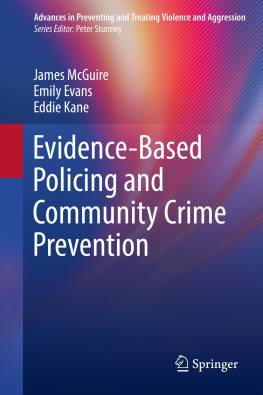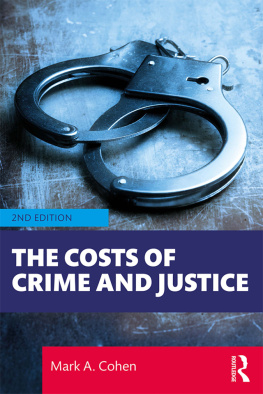THE POLITICS OF CRIME PREVENTION
The Politics of Crime Prevention
BRIGITTE C.M. KOCH
Institute of Criminology
University of Cambridge
First published 1998 by Ashgate Publishing
Reissued 2018 by Routledge
2 Park Square, Milton Park, Abingdon, Oxon OX14 4RN
711 Third Avenue, New York, NY 10017, USA
Routledge is an imprint of the Taylor & Francis Group, an informa business
Copyright Brigitte C.M. Koch 1998
All rights reserved. No part of this book may be reprinted or reproduced or utilised in any form or by any electronic, mechanical, or other means, now known or hereafter invented, including photocopying and recording, or in any information storage or retrieval system, without permission in writing from the publishers.
Notice:
Product or corporate names may be trademarks or registered trademarks, and are used only for identification and explanation without intent to infringe.
Publishers Note
The publisher has gone to great lengths to ensure the quality of this reprint but points out that some imperfections in the original copies may be apparent.
Disclaimer
The publisher has made every effort to trace copyright holders and welcomes correspondence from those they have been unable to contact.
A Library of Congress record exists under LC control number: 97077390
ISBN 13: 978-1-138-34436-5 (hbk)
ISBN 13: 978-1-138-34439-6 (pbk)
ISBN 13: 978-0-429-43854-7 (ebk)
This research examined how national crime prevention policy was structured, organised and determined in England and Wales between 1979 and 1997 with a particular focus between 1995 and 1997.
The research examined the agencies that were in a position to influence national crime prevention policy. They included: the Home Office, the police service, the probation service, Crime Concern, NACRO, local authority associations and the National Community Safety Network. The relationships between these agencies were addressed, as well as the role of political ideology in national crime prevention policy.
Several issues were addressed in the research. These issues aimed to:
1) investigate what crime prevention means at the national level;
2) study the nature of crime prevention policy making;
3) examine the role of the individual in making things happen;
4) investigate the extent of political ideology in crime prevention policy;
5) investigate the influence of politicians on policy making;
6) examine the relationship between political ideology and research/practice;
7) examine trends that have occurred over the past fifteen years;
8) investigate how national crime prevention is organised, including the role played by national crime prevention (sub) committees;
9) determine the prominence of crime prevention within each agency examined in this research;
10) examine the role of each agency in crime prevention policy making;
11) determine who has responsibility for crime prevention;
12) investigate whether national instructions for local practice are consistent with national practice;
13) investigate whether issues raised at the national level in this research are also applicable to local level research done by others;
14) to determine whether perceived roles of local police and probation officers in Boroughville are consistent with national findings.
The methods used within the research included reviewing the literature; interviewing key crime prevention policy makers; analysing internal documentation such as annual reports, pamphlets, training materials, internal letters or memos, minutes to meetings, and publications from the organisation itself, and finally; surveying both police and probation officers in one city (named Boroughville in the research) through the use of a questionnaire.
Results of the research showed that over the past eighteen years in England and Wales, national crime prevention policy was very much influenced by Conservative party ideology and by the identity of the Home Secretary and the Minister responsible for crime prevention. This not only affected policies, but also the selection of advisors. Crime Prevention since 1979 has very much focused on situational approaches. Criminality prevention or offender oriented approaches has received much less attention in comparison. Under the Conservative government, crime prevention was assigned to the police service, although other agencies were recognised as playing a role.
The research suggests that national crime prevention policy is forever changing. Structures change within organisations and people (including political figures) change every few years. These changes that occur at the national level affect policies which filter down to the local level and influence the types of crime prevention activities that receive central government funding.
Although national policies do influence local practice through funding, the practical responsibility of the Home Office in crime prevention has been dispersed with the establishment of the Single Regeneration Budget and Crime Concern. The tactic over the past few years is one of diminishing the role of the state, and increasing the notion of individual responsibility.
This research was designed to provide insight into crime prevention policy in England and Wales during the period 1979-1997.
Having read the acknowledgments in Maureen Cains (1973) book that she completed her doctoral thesis while boiling nappies on the gas stove was of great inspiration in my own work. I do hope that one day, this work will inspire another mum to complete her studies.
Having said all this, this book would not have been possible without the help and time that so many provided, and to whom I owe much gratitude. However, due to the fact that confidentiality was assured, it is not possible to thank these people individually. Nevertheless, I do greatly appreciate the honesty and openness and information provided by those interviewed. In some instances over five or six hours were spent, explaining various aspects of crime prevention policy, or in developing the questionnaires to be sent out to police and probation officers. I do sincerely hope that these people recognise themselves in this paragraph.
Many thanks also go to all the police officers and probation officers who took the time to fill in the questionnaires and to the services themselves for granting access for this research. Here again, the author is tempted to thank a few key people, but since the services surveyed are to remain anonymous I do hope that these people know who they are.
Dr. Trevor Bennett, my supervisor, was also instrumental in completing this research. His comments and support throughout the years are greatly appreciated.
Finally, I would like to thank those at home: my husband for his continual encouragement, support and confidence; my son Alexander for his patience; and my daughter Rachel who waited until I finished my work before coming into this world (she was born within hours of my completing my PhD).
Crime and crime prevention theories are influenced by the social and economic context and have evolved over time. This is linked to the society we live in and to the politics of the day (Sykes and Cullen, 1992). Bottoms and Wiles (1996: 10) indicated that the development of contemporary forms of crime prevention can best be understood as part of a much wider process of change in contemporary Western societies.







